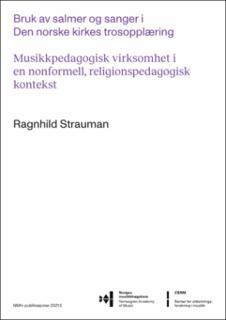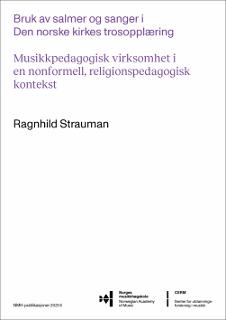| dc.contributor.author | Strauman, Ragnhild | |
| dc.date.accessioned | 2021-08-23T06:23:23Z | |
| dc.date.available | 2021-08-23T06:23:23Z | |
| dc.date.issued | 2021 | |
| dc.identifier.isbn | 978-82-7853-295-9 (pdf) | |
| dc.identifier.isbn | 978-82-7853-294-2 (trykt) | |
| dc.identifier.issn | 0333-3760 | |
| dc.identifier.issn | 2535-373X (online) | |
| dc.identifier.uri | https://hdl.handle.net/11250/2770637 | |
| dc.description | Avhandling (Ph.D.) - Norges musikkhøgskole, Oslo 2021 - Dissertation for the PhD degree Norwegian Academy of Music, Oslo 2021 | en_US |
| dc.description.abstract | Sammendrag. -
Avhandlingen har sitt utgangspunkt i trosopplæringsreformen som ble vedtatt av Stortinget i 2003. Kirkelig utdanningssenter nord (KUN/VID Tromsø) fikk i 2014 bevilget forsknings- og utviklingsmidler fra Kirkerådet for å forske på bruk av salmer og sanger i Den norske kirkes trosopplæring. Denne forskningen gikk over i et doktorgradsprosjekt ved Norges musikkhøgskole som munner ut i denne avhandlingen: Bruk av salmer og sanger i Den norske kirkes trosopplæring. Musikkpedagogisk virksomhet i en nonformell, religionspedagogisk kontekst. Tittelen viser både til innholdet og til forskningsfeltet som studien forholder seg til; den aktualiserer bruken av salmer og sanger i et trosopplæringsperspektiv, plassert som musikkpedagogisk forskning i en avgrenset kirkelig, religionspedagogisk sammenheng. I Norge er dette et bortimot uutforsket felt, som fortjener større oppmerksomhet. Hensikten med studien var for det første å finne ut hvilke salmer og sanger som synges i forbindelse med aktiviteter for barn og unge i Den norske kirke, dernest å undersøke hvordan kirkemusikere og menighetspedagoger reflekterte rundt sine valg og sin rolle i trosopplæringen.
Hovedproblemstillingen for studien er: Hvilke dannelsespedagogiske perspektiver kommer til uttrykk i repertoarvalget og informantenes refleksjon omkring dette, og hvilken betydning kan disse perspektivene ha for en kirkemusikkpedagogisk grunnlagstenkning? Datamaterialet består av spørreskjemaer og samtaleintervjuer, der funn fra to ulike innsamlings- og analysemetoder analyseres både hver for seg og i sammenheng med hverandre («mixed methods»). Innsamlingen ble gjort i perioden 2015–2017 og startet med innhenting av informasjon om blant annet salme- og sangvalg fra 48 menigheter, fordelt på 11 bispedømmer. Spørreskjemaene ble deretter fulgt opp av samtaleintervjuer med 8 kantorer og 4 kateketer, basert på funn fra spørreskjemaene.
Den vitenskapsteoretiske forståelsesrammen i studien er kritisk realisme. Jeg forholder meg til den ontologiske realismen, den kritiske dømmekraften og den epistemologiske relativismen slik den forklares av Margareth Archer, Doug Porpora, Andrew Collier og Andrew Wright, nærmere bestemt en kritisk realisme som forholder seg til Guds eksistens eller ikke-eksistens. En hermeneutisk tilnærming til datamaterialet fungerer som en bro mellom den kritiske realismen og det dannelsespedagogiske teoretiske grunnlaget for analyser, funn og drøfting, som i sum er studiens bidrag til forskningsfeltet.
Studien viser at det er en stor variasjon i salme- og sangvalget og at både kantorer og kateketer forholder seg til musikkopplæringen i kirken som en viktig tilnærmingsmetode til kristen kunnskap og praksis. Kriterier for salmevalg begrunnes også estetisk, rituelt og intergenerasjonelt, men den refleksive og den eksistensielle dimensjonen er svakt artikulert i datamaterialet. I barnekorarbeidet velger kirkemusikerne mer variert når det gjelder sjanger enn det menighetspedagogene gjør, mens menighetspedagogene velger mange flere salmer og sanger knyttet til livsmestrings- og livstolkningstemaer enn det kirkemusikerne gjør. Ved hjelp av den kategoriale dannelsestenkningen slik den fremstilles av blant andre Wolfgang Klafki, Frede V. Nielsen og Dietrich Benner, har jeg forsøkt å belyse den refleksive og den eksistensielle dimensjonen som en del av den musikkpedagogiske virksomheten. Den dobbeltsidige åpning, musikkens bevissthetslag og det mangespektrede univers, samt det pedagogiske paradoks som handler om barnets Bildsamkeit og den ikke-affirmative oppfordringen til selvvirksomhet er vesentlige elementer for en kirkemusikkpedagogisk grunnlagstenkning. Her har jeg også introdusert hymnicking – «å salme» som kirkens svar på Christopher Smalls musicking-begrep.
Barne- og ungdomskorarbeidet i Den norske kirke er gode eksempler på en musikkpedagogisk virksomhet som også forholder seg til åndelighet og tro. Når barn oppdras til og gjennom musikk impliserer det en åpen undervisning, der barnet selv må møte et lærestoff som åpner verden for barnet, og der barnet åpner seg for verden. Barnet som ikke utsettes for indoktrinering, men opplever respekt for å stille spørsmål, reflektere og ta sine egne valg, har de beste forutsetningene for å utvikle sin egen evne til livstolkning og livsmestring. Dette stiller krav til kirkens ansatte om å se kirkens musikkundervisning som en del av barnets estetiske oppdragelse, i samarbeid med skole, hjem og samfunn. En oppdragelse som ikke bare har et religionspedagogisk sikte, men også et estetisk, etisk og politisk sikte. Den musikkpedagogiske virksomheten i den nonformelle, religionspedagogiske konteksten skal, kort sagt, kunne hjelpe barnet til å finne sin plass i sitt eget liv, i seg selv og som verdensborger. | en_US |
| dc.description.abstract | Summary. -
This study is based on the Faith Education Reform, commenced by the Norwegian Parliament in 2003. The education centre for the Church of Norway in the north (KUN/VID Tromsø) was awarded research funding from the General Synod of the Church of Norway in order to study hymn singing as a part of the Christian education. This research expanded into a doctoral study at the Norwegian Academy of Music, resulting in this thesis: Singing Hymns and Songs in the Christian Education Within the Church of Norway: Music Educational Activity in a Non-formal, Religious Educational Context.
The title refers both to the content and to the field of research to which the study relates; it actualizes the use of hymns and songs in a faith education perspective, placed as music pedagogical research in a limited ecclesiastical, religious pedagogical context. In Norway, this is a virtually unexplored field which deserves greater attention. The purpose of the study was firstly to find out which hymns and songs are sung in connection with activities for children and young people in the Church of Norway, secondly to investigate how church musicians and parish educators reflected on their choices and their role in faith education.
The main research question for the study is: What educational pedagogical perspectives are expressed in repertoire choices and the informants’ reflection on this, and what significance can these perspectives have for essential thinking in church music pedagogy?
The data material consists of questionnaires and interviews, where findings from two different collection and analysis methods are analyzed both individually and in connection with each other (mixed methods). The collection was made in the period 2015–2017 and started with obtaining information including hymn and song selections from 48 congregations, divided into 11 dioceses. The questionnaires were then followed up by interviews with 8 church musicians and 4 catechists, based on findings from the questionnaires.
The scientific theoretical framework of the study is critical realism. I utilize ontological realism, the critical judgment and the epistemological relativism as explained by Margareth Archer, Doug Porpora, Andrew Collier and Andrew Wright, more specifically a critical realism that also relates to the existence or non-existence of God. A hermeneutic approach to the data material serves as a bridge between the critical realism and the pedagogical theory of Bildung as a basis for analyzes, findings and discussion, which in total constitute the study’s contribution to the research field.
The study shows that there is a great variety in the choice of hymns and songs and that both church musicians and catechists view music education in the church as an important approach to Christian knowledge and practice. Criteria for hymn selection are also justified aesthetically, ritually, and intergenerationally, but the reflexive and the existential dimension are weakly articulated in the data material. When working with children’s choirs, the church musicians choose more varied in terms of genre than the parish educators do, while the parish educators choose more songs with contents aiming at interpreting life and mastering the art of living. On the basis of the concept of Bildung, mainly as it is presented by Wolfgang Klafki, Frede V. Nielsen and Dietrich Benner, I have tried to illuminate the reflexive and the existential dimension as part of the music pedagogical activity. The double-sided opening, the music layer of consciousness and the multifaceted universe, as well as the pedagogical paradox that deals with the child’s Bildsamkeit and the non-affirmative call for self-activity are essential elements for a church music pedagogical basis for thinking. Here I have also introduced hymnicking – “to hymn” as the church’s answer to Christopher Small’s concept of musicking.
The children’s and youth choirs in the Church of Norway are good examples of a music pedagogical activity that also relates to spirituality and faith. When children are brought up to and through music, it implies an open teaching, where the child himself must encounter a learning material that opens the world to the child, and where the child opens up to the world. The child who is not exposed to indoctrination, but experiences respect for asking questions, reflecting and making his or her own choices, has the best conditions for developing his or her own ability for life interpretation and mastery of life. This places demands on the church’s employees to see the church’s music teaching as part of the child’s aesthetic upbringing, in collaboration with school, home and society. An upbringing that not only has a religious pedagogical aim, but also an aesthetic, ethical and political aim. The music educational activity in the non-formal, religious pedagogical context should, in short, be able to help the child to find his place in his own life, in himself and as a world citizen. | en_US |
| dc.language.iso | nob | en_US |
| dc.publisher | Norges musikkhøgskole | en_US |
| dc.subject | Den norske kirke | en_US |
| dc.subject | salmerepertoar | en_US |
| dc.subject | musikkundervisning | en_US |
| dc.subject | musikkopplæring | en_US |
| dc.subject | barnekor | en_US |
| dc.subject | hymnicking | en_US |
| dc.title | Bruk av salmer og sanger i Den norske kirkes trosopplæring. Musikkpedagogisk virksomhet i en nonformell, religionspedagogisk kontekst | en_US |
| dc.title.alternative | Singing hymns and songs in the Christian education within the Church of Norway: Music educational activity in a non-formal, religious educational context | en_US |
| dc.type | Doctoral thesis | en_US |
| dc.description.version | publishedVersion | en_US |
| dc.subject.nsi | VDP::Humaniora: 000::Musikkvitenskap: 110::Musikkpedagogikk: 114 | en_US |
| dc.source.pagenumber | xii, 286 sider | en_US |

